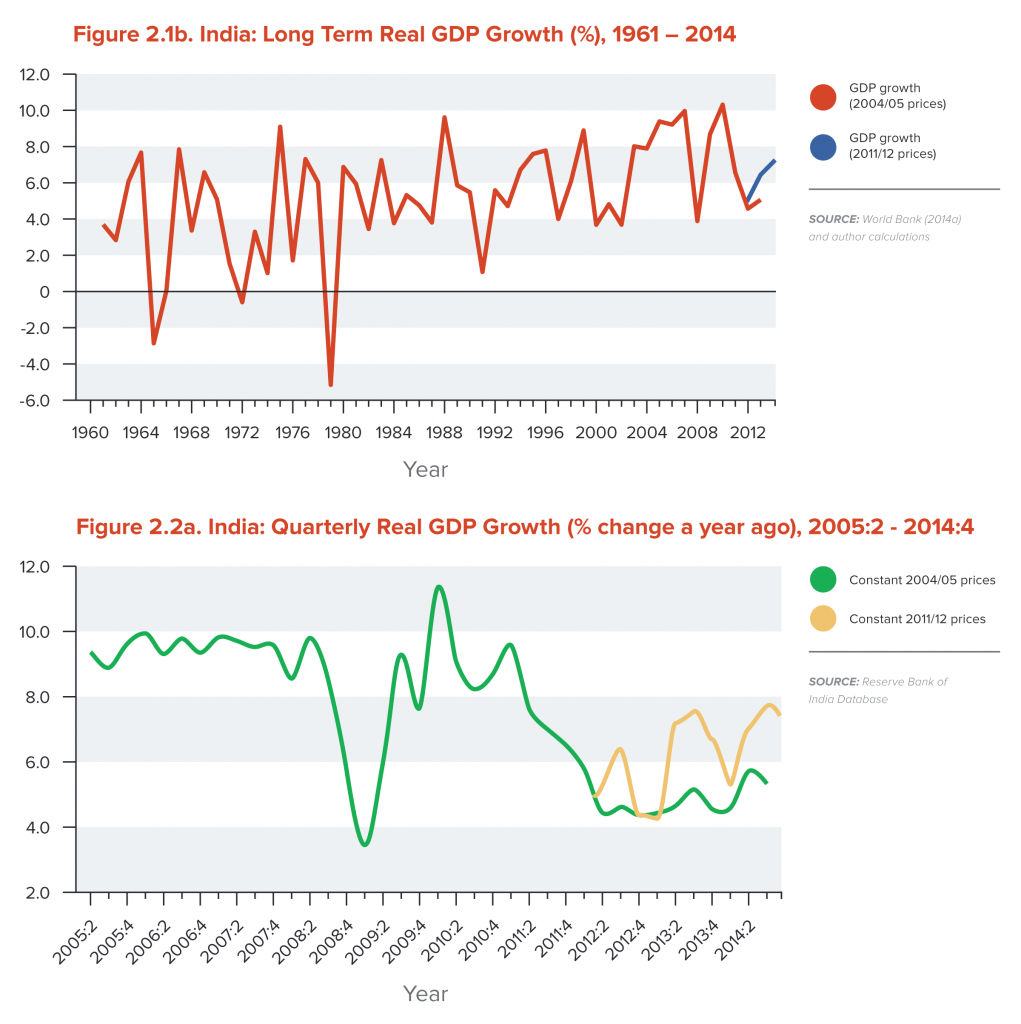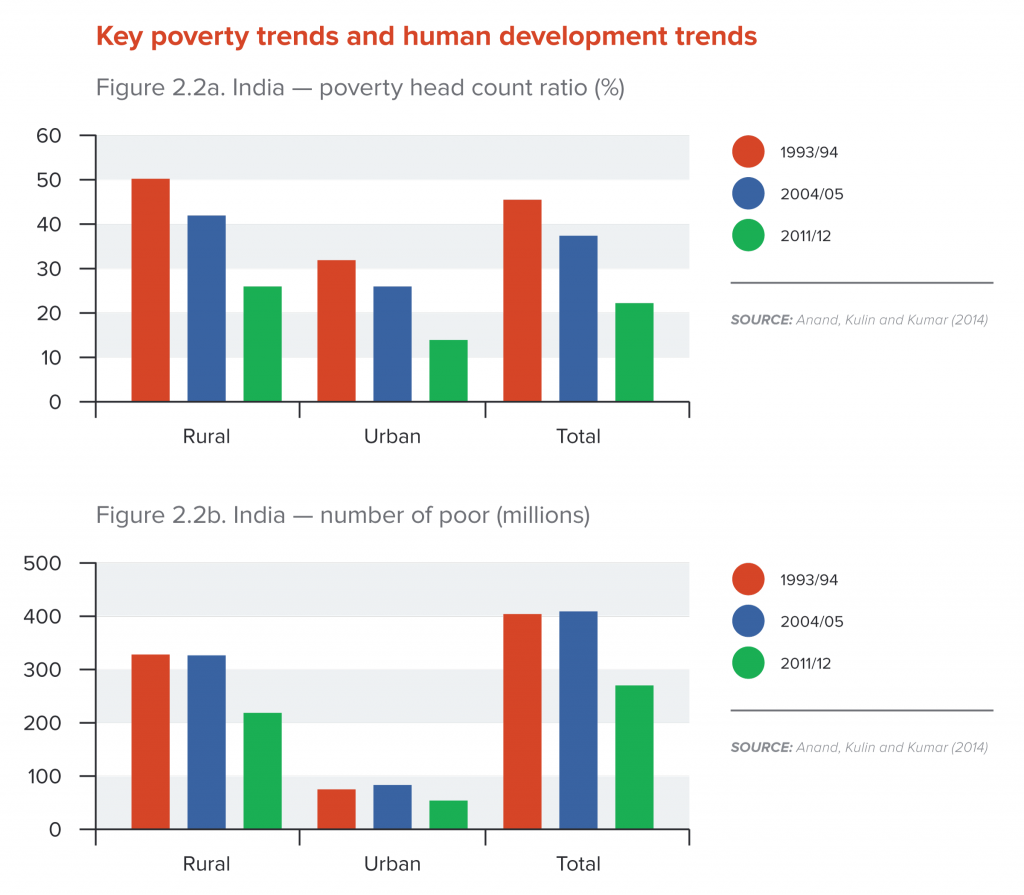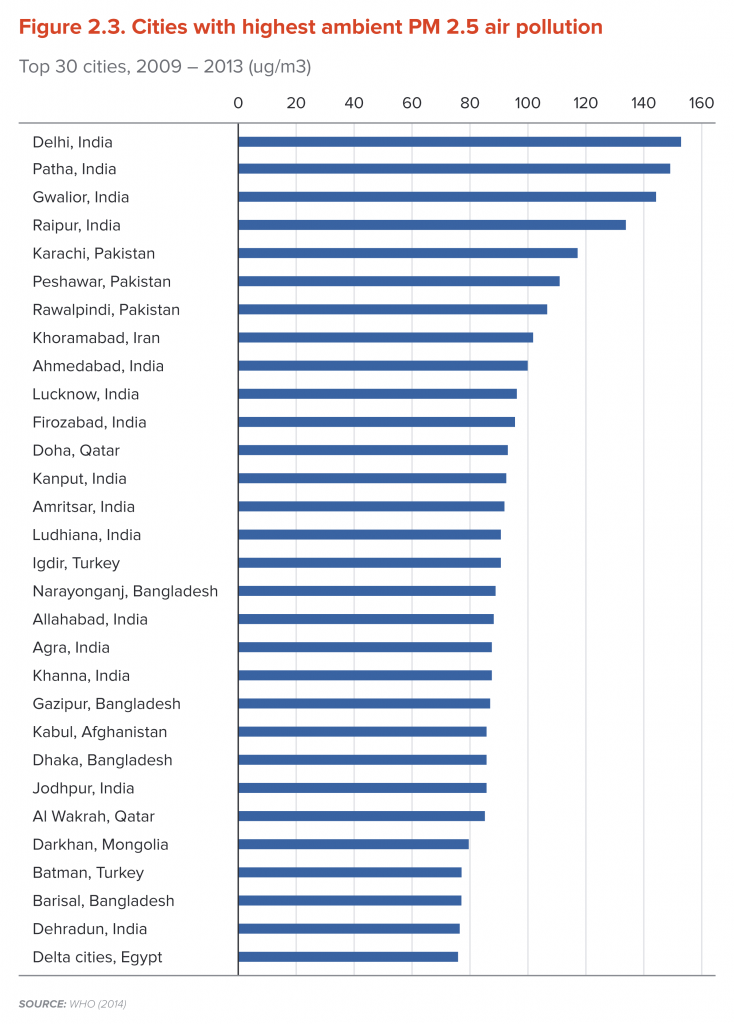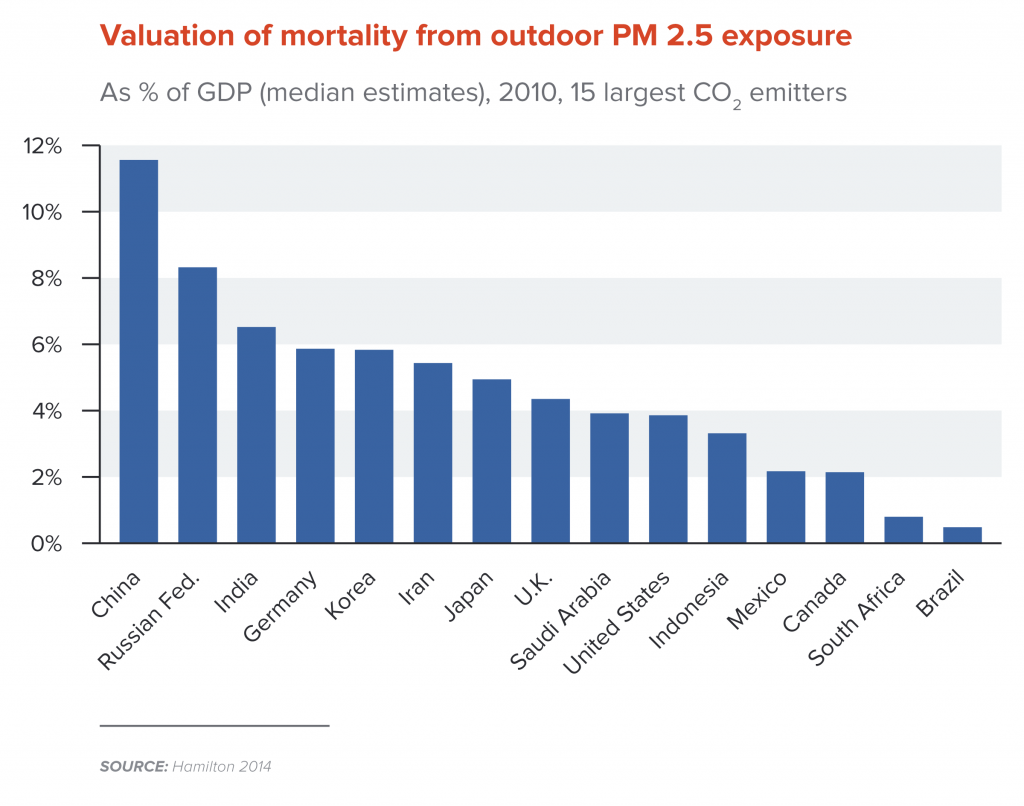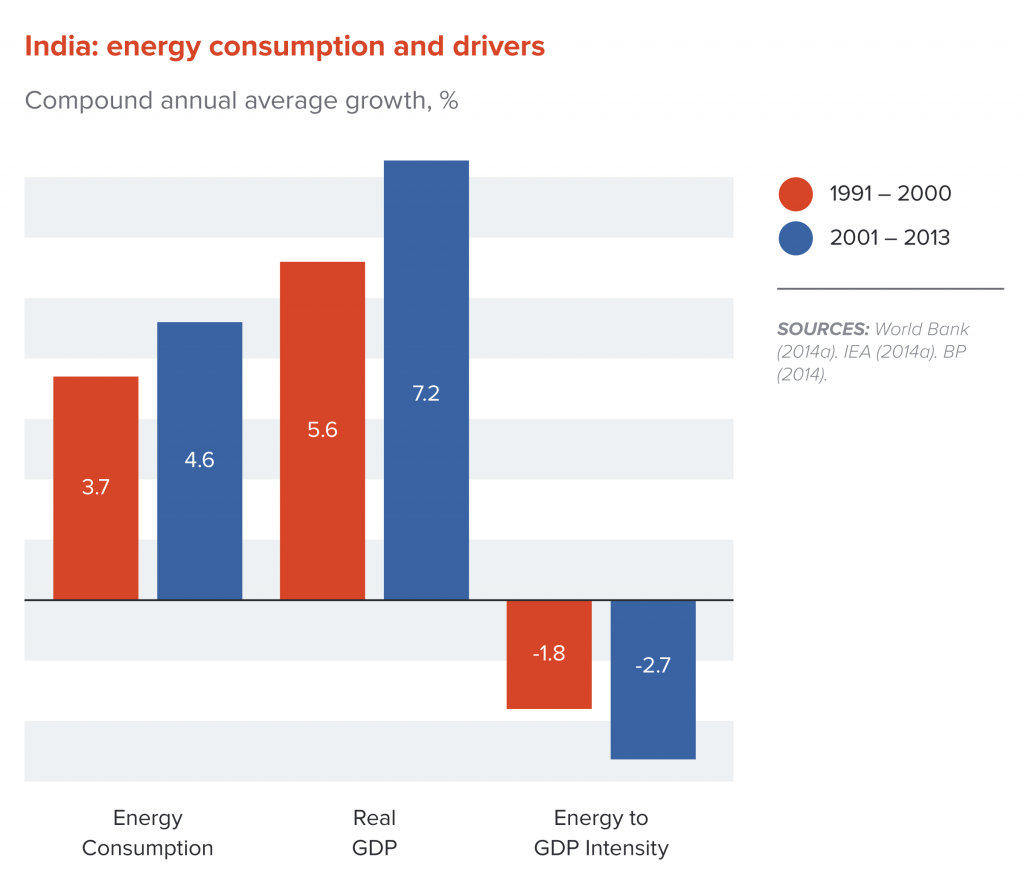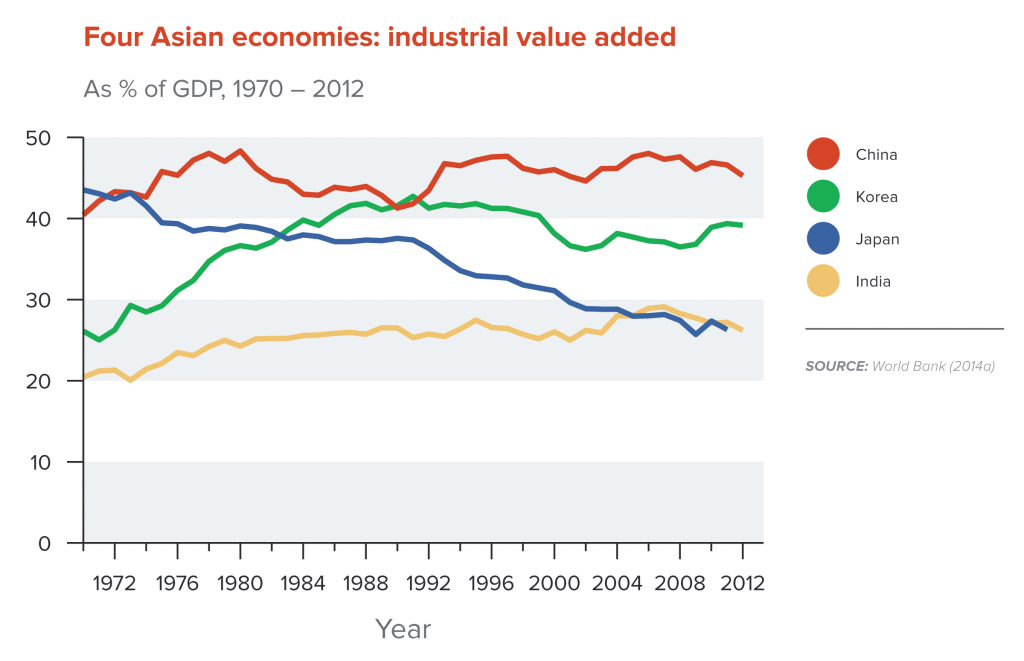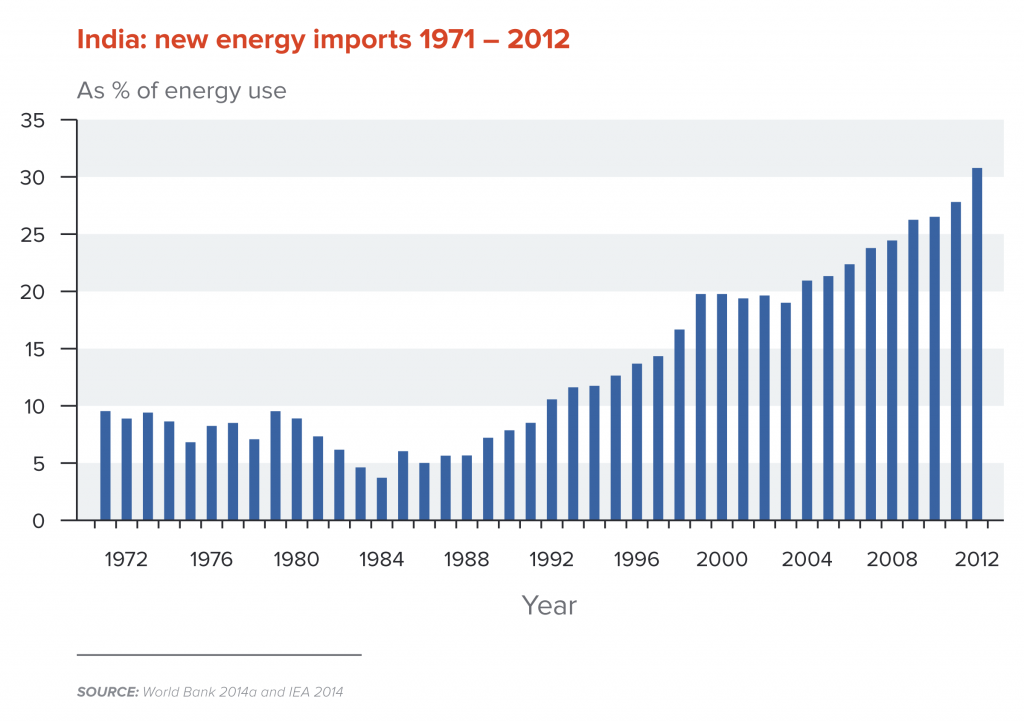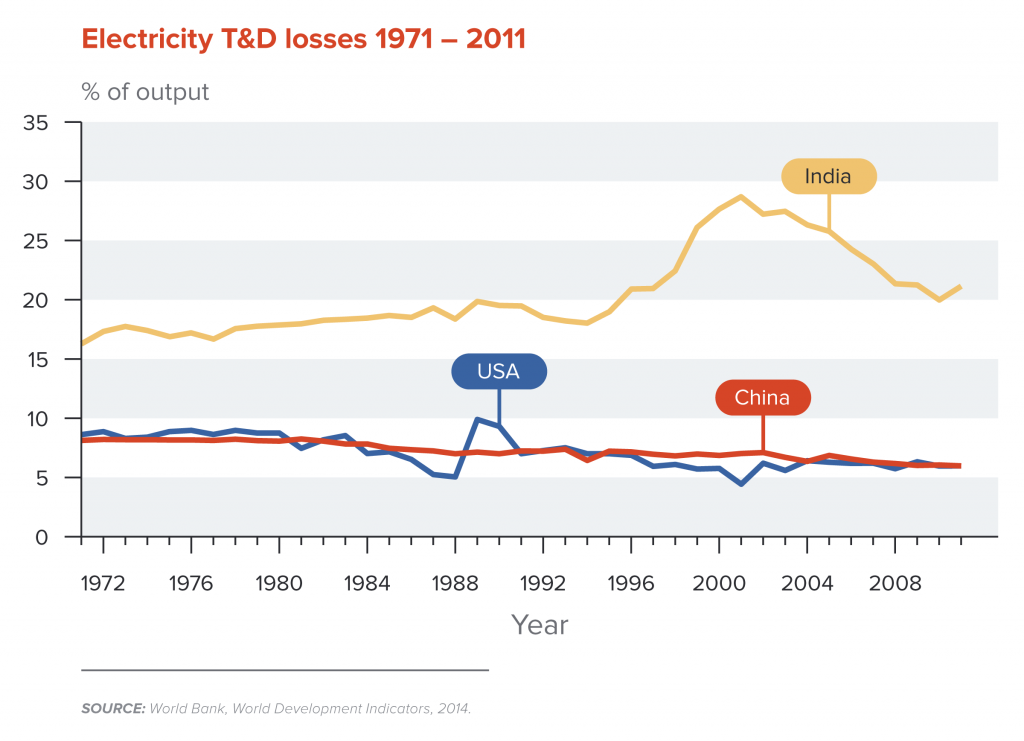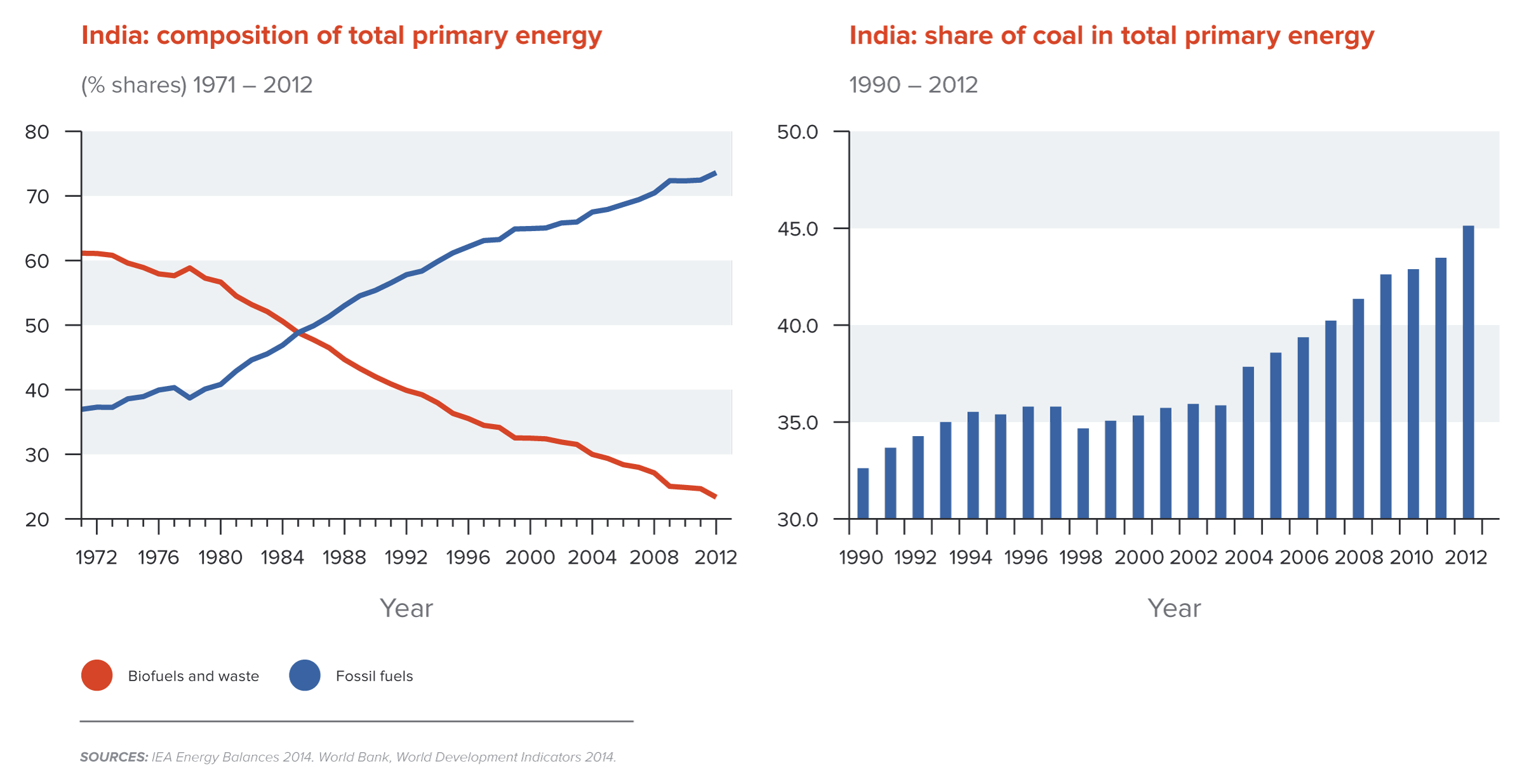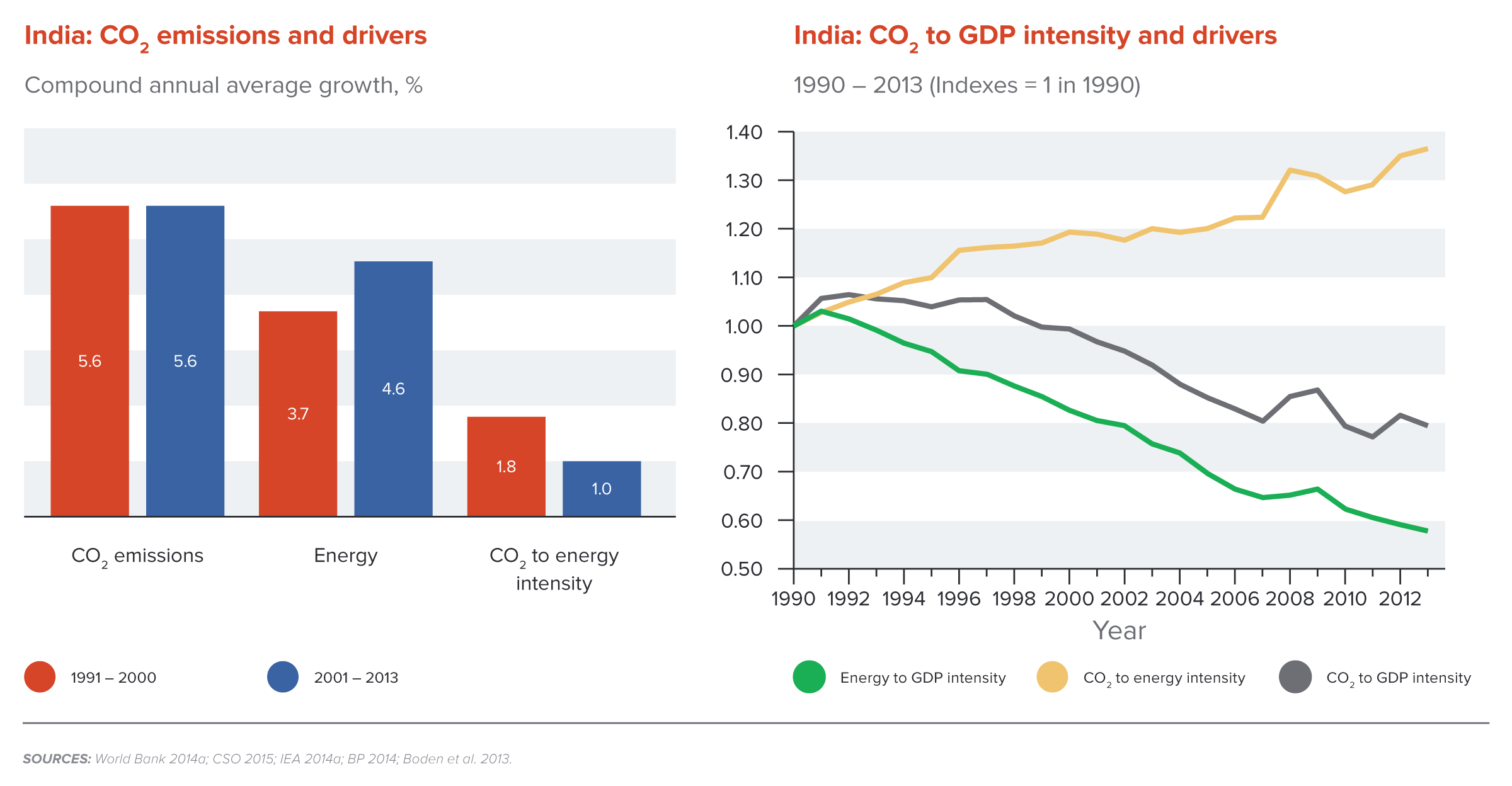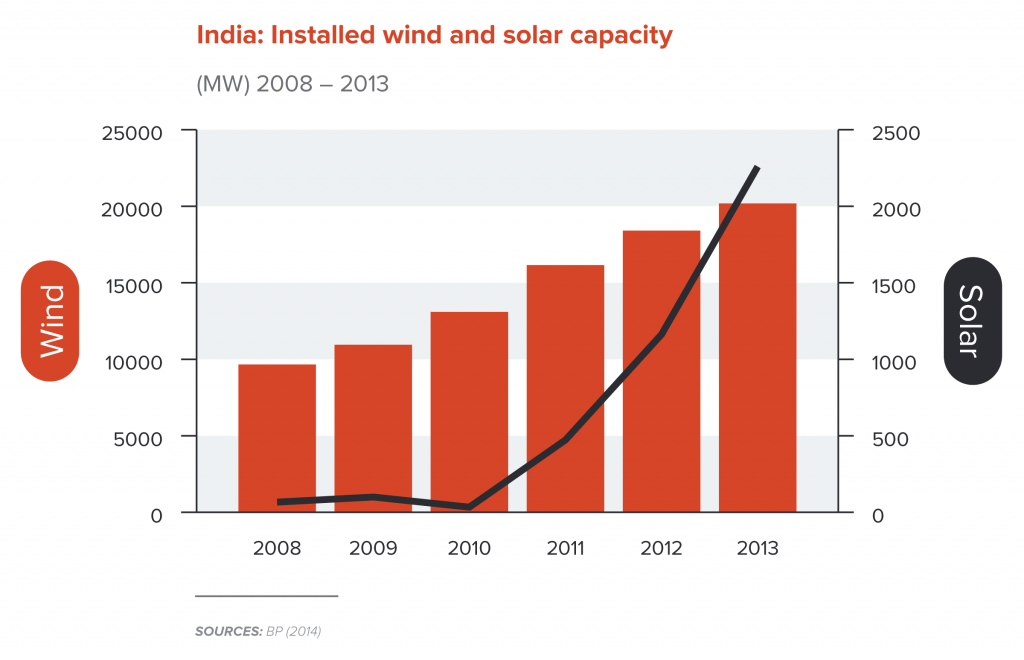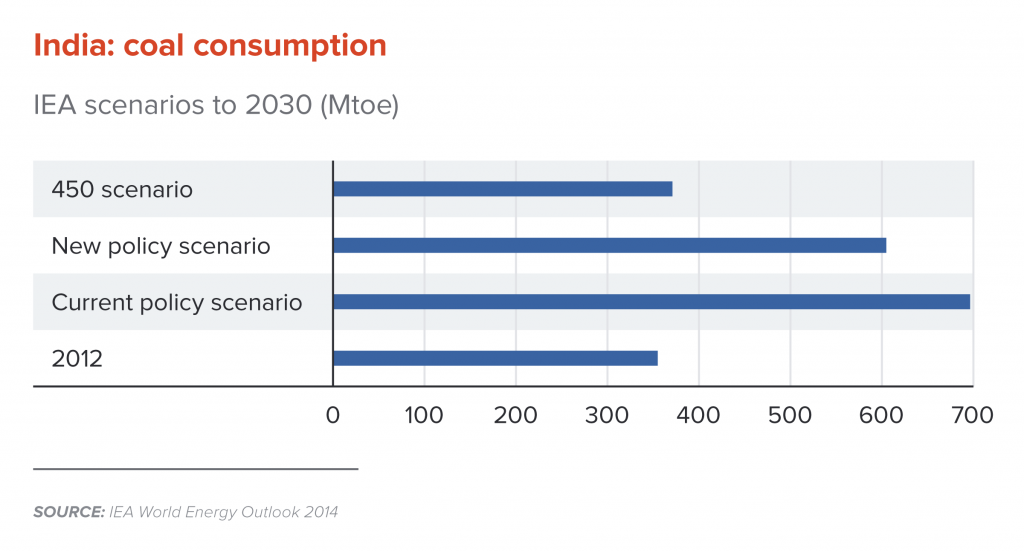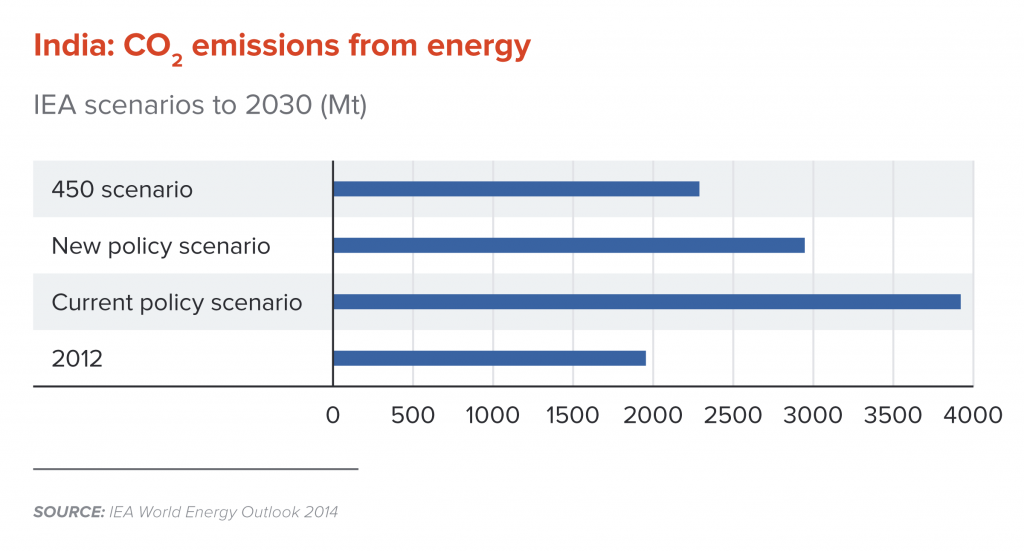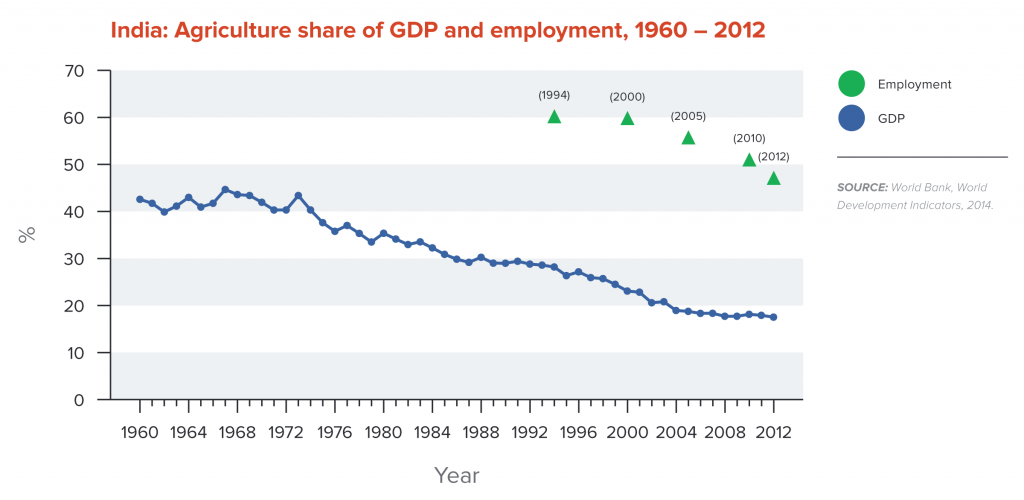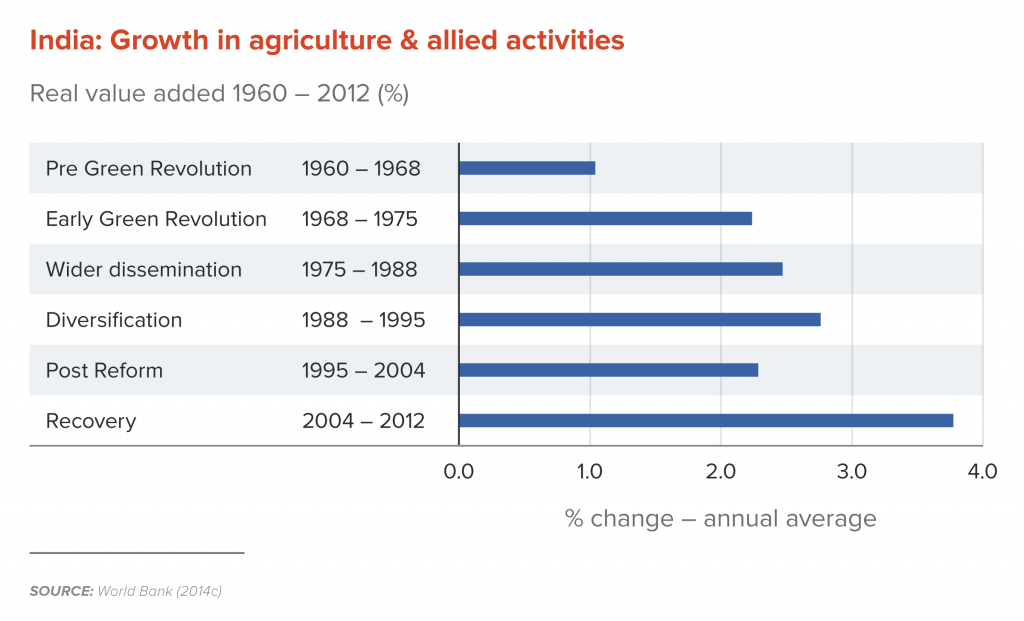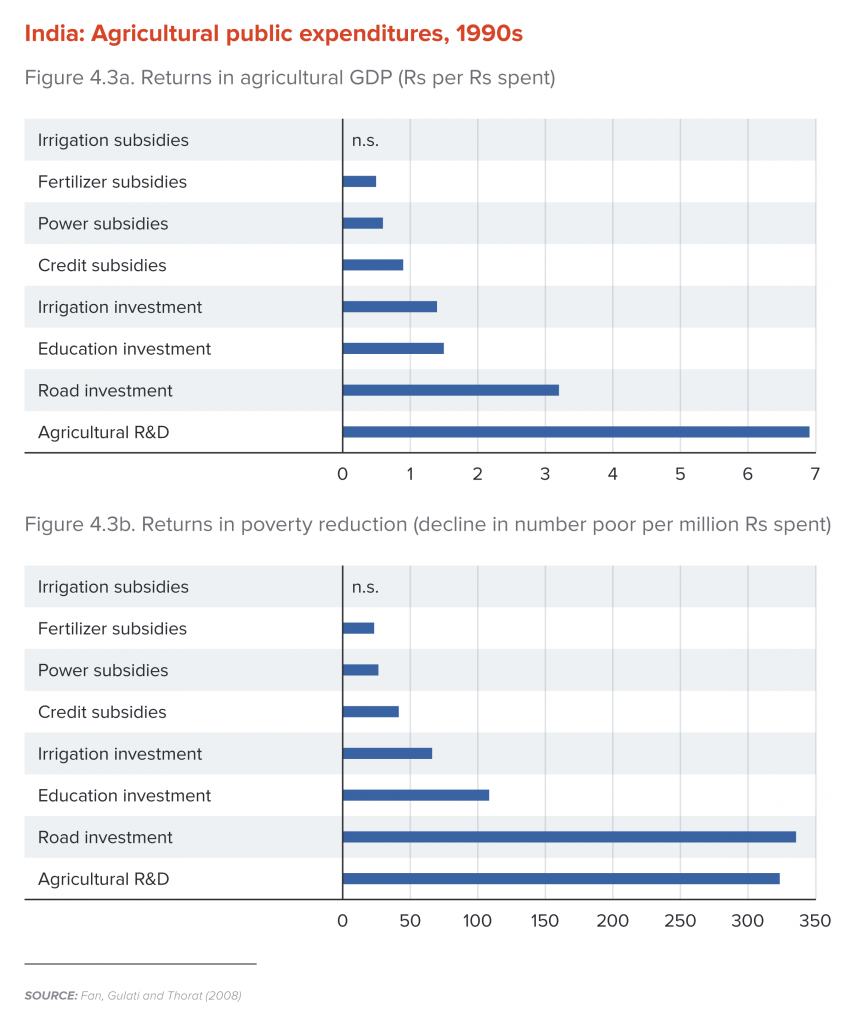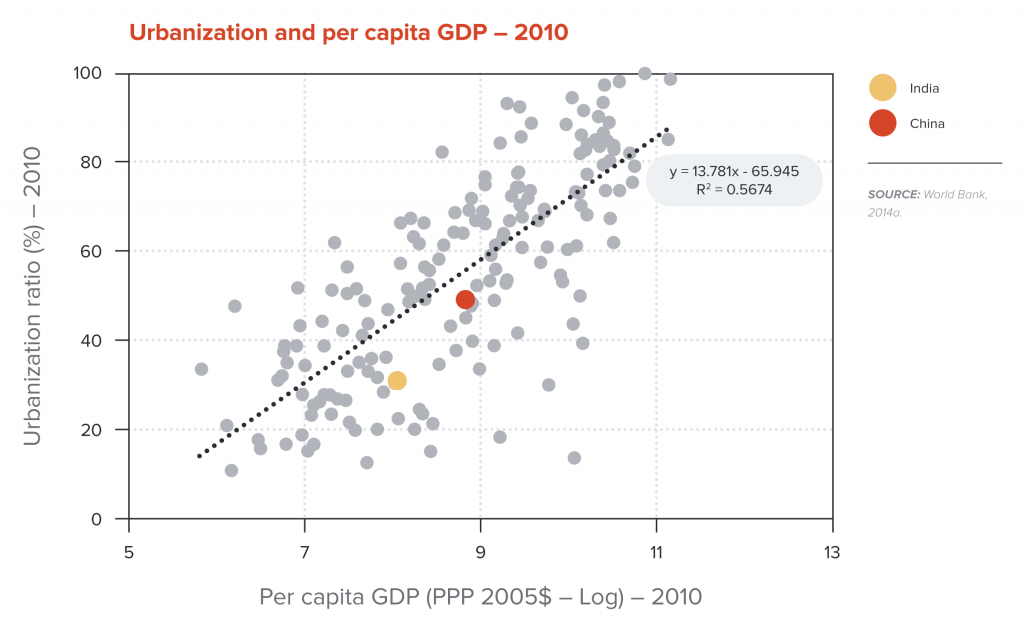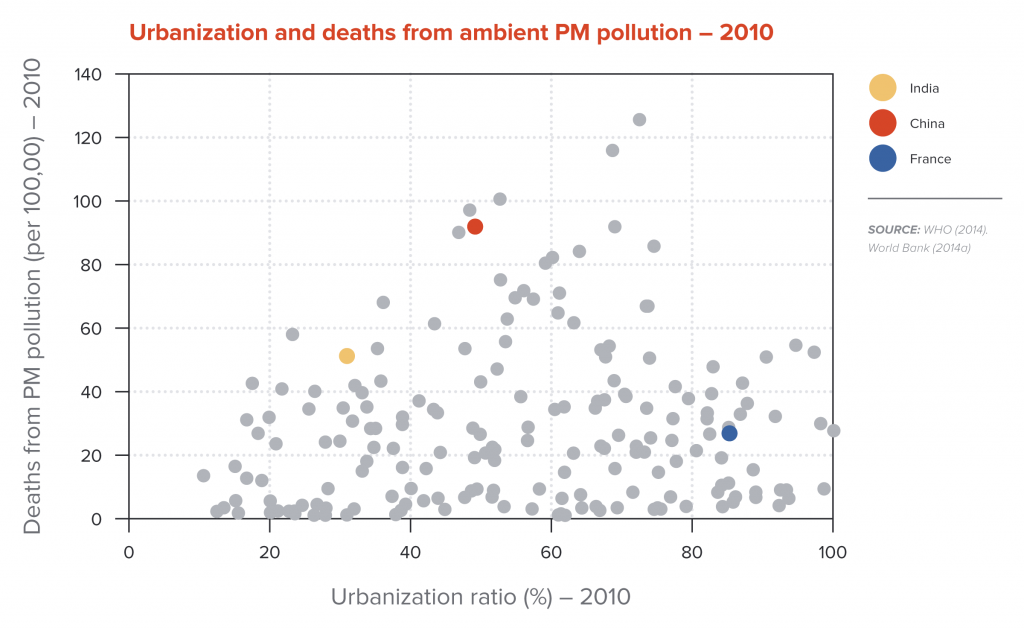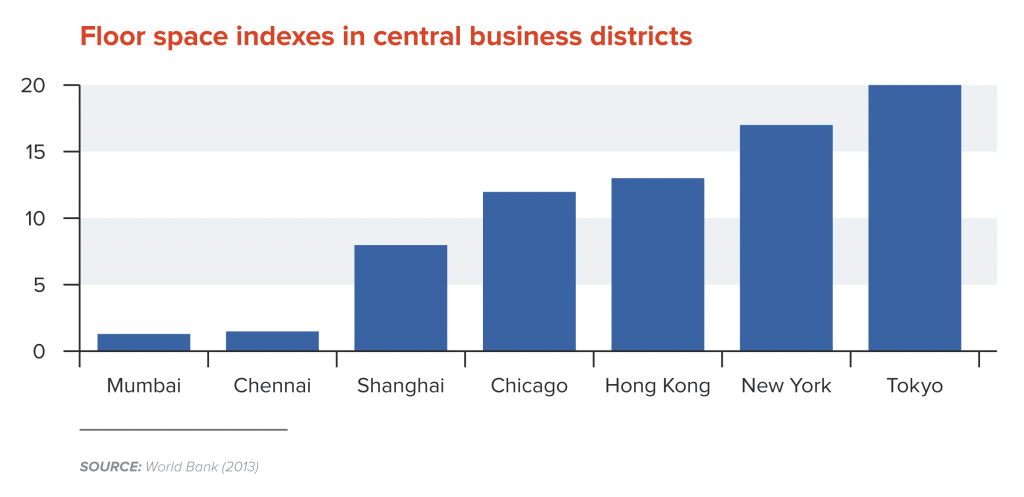In 2014 Prime Minister (PM) Narendra Modi’s government was elected with a strong mandate to jumpstart rapid development that is both inclusive and sustainable. The “Make in India” initiative aims to streamline investment regulations and proposes major infrastructure expansion to support rapid growth in manufacturing, including development of smart cities and industrial corridors. Financial inclusion of the poor has significantly increased, with over 100 million new bank accounts opened in just a few months under the Jan Dhan Yojana initiative. All bank accounts are to be linked to the Aadhaar electronic ID system, which will facilitate modernisation of government service delivery and social protection programmes. Fuel subsidies have been reduced or eliminated. PM Modi said that India views global concerns about climate change as a great opportunity for working towards the well-being of its citizens, and making a positive contribution for mankind, noting that there is a need for a broader perspective on progress in clean energy generation, energy conservation and energy efficiency.1
This paper by the New Climate Economy’s India Initiative argues that India’s efforts to achieve rapid, inclusive and sustainable development have been hampered in the past by pervasive inefficiencies that arise from market, policy and institutional failures and weaknesses. Efforts to address these weaknesses in a comprehensive manner can significantly increase the pace of improvement in the well-being of the population while also better tackling environmental and climate risks. Drawing on the framework developed in the recent New Climate Economy report, Better Growth, Better Climate, we focus on three critical socio-economic systems where increased efficiency, investment and innovation can yield major development and environmental benefits: energy systems, agriculture and land use, and cities. 2
1.2 India’s recent development performance and its challenges
India’s economic performance since the start of the 21st century provides grounds for both optimism and concern; which assessment prevails will likely turn on the policy choices made today and in the next few years.
India experienced the most sustained period of rapid growth in its economic history during the 2000s – an average of close to 9% a year between 2003/04 and 2010/11 – even taking into account a brief but sharp slowdown in 2008/09, during the global economic crisis. Rapid growth in the 2000s contributed to an unprecedented fall in poverty. The poverty headcount rate (using the national poverty line) fell from 37% in 2004/05 to 22% in 2011/12, an extraordinary decline over so short a period.
More recently growth slowed to only around 5% in 2012/13. Recent data provide inconsistent evidence as to the extent of the recovery from this slowdown. Cross-country analysis suggests that, while many countries enjoy temporary growth booms, this is nearly always followed by a “reversion to the mean” and more mediocre growth. For India to join the select group of countries that achieve sustained rapid growth over several decades will require policy-makers to provide a relentless focus on finding and unblocking the critical obstacles and constraints to structural change and inclusive growth.
A second, broader concern is that the benefits of faster GDP growth in recent years are being undermined by unplanned harmful spill-overs from the current growth model – severe local air pollution and damage to health, rising energy insecurity due to an increasing share of coal and other energy imports, excessive drawdown of groundwater in agriculture, and the costs of a rapid but problematic urbanisation, such as periurban sprawl, congestion, pollution and reduced urban productivity. Thus, even as it grapples with the problems of how to achieve rapid and inclusive economic growth, India also has to ensure that growth is sustainable – that its natural assets are able to continue providing the resources and environmental services on which the well-being of present and future generations depends.
Some 2 million (or over 20%) of all premature deaths in India in 2010 were related to some type of environmental risk. Of these, the most important is household air pollution from burning solid fuels, which is estimated to be responsible for just over 1 million premature deaths. Some 49% of households in India rely on firewood for cooking, especially in rural areas. In poorly ventilated buildings, indoor smoke can be 100 times higher than acceptable levels for small particles. The health risks are especially great for women and girls who do most of the cooking. A major push to expand access to electricity and provide improved cleaner cookstoves will therefore have a significant co-benefit in terms of reduced illness and deaths from household air pollution.
Outdoor (ambient) particulate matter (PM) pollution caused an estimated 630,000 premature deaths in India in 2010. Of the 30 cities with the worst ambient PM2.5 pollution worldwide, 15 are in India, including the top four. Estimates place a statistical value of lives prematurely lost annually in India due to ambient PM2.5 pollution at 5.5–7.5% of GDP. Since PM2.5 pollution and CO2 emissions both come largely from the same source – the burning of fossil fuels – it is important to consider the large health benefits from reduced air pollution associated with abatement of CO2 emissions. For India these benefits are estimated at US$55 per tonne of CO2 abated, close to double the US government’s estimate of US$32 per tonne for the climate change benefits of reducing CO2 emissions. Importantly from the perspective of Indian policy-makers, the air quality benefits are not only larger, they are enjoyed in the near term; accrue locally, mostly to the country itself; and are more certain compared with climate change benefits.
In the remainder of this paper we argue that key reforms in energy, urban and agricultural policies and institutions can unlock more rapid economic growth and improved welfare for the Indian public while tackling many of the unwanted national side-effects of the existing model of growth, such as severe air pollution and growing energy insecurity. Such reforms also provide substantial avenues for India to make its due contribution to cooperative global efforts to mitigate greenhouse gas (GHG) emissions, and climate risks.
1.3 Key development challenges and opportunities in the energy sector
India consumes a relatively small amount of energy in both absolute and per capita terms compared with other major economies such as the OECD (Organisation for Economic Co-operation and Development) countries or China. But energy consumption is growing rapidly, at 4.6% per year in 2000–13, which represents a doubling in 15 years. This growth can be broken down into 7.2% annual GDP growth, minus about 2.6% annual decline in the energy intensity of GDP. Growth in energy demand in India is likely to remain robust, not only because of fast economic growth but also because of structural trends, such as increasing industrialisation and urbanisation, which tend to boost demand. Unlike China, much of India’s manufacturing development still lies in the future. Domestic energy production has not kept pace with quickly rising consumption, so that energy imports have surged. Energy has become central to the country’s chronic trade imbalance, with rising energy insecurity an important concern for policy-makers. India’s international trade deficit for fuels averaged an annual 6.4% of GDP over 2008–12 – twice the size of its current account deficit, which averaged 3.2% of GDP annually in this period. The current account deficit has fallen recently, in part because of lower world oil prices. The country’s external position nevertheless remains vulnerable to volatility in energy prices. These trends underline the importance of reforms to reduce unnecessary existing inefficiencies and waste in energy use.
Alongside fast growth in energy demand, India’s energy supply has also become steadily more carbon intensive as the share of fossil fuels has risen, in particular with growing use of coal for electricity generation, and diesel and gasoline for transport. The combination of fast growth in energy demand and the rising carbon intensity of energy has resulted in the rapid increase of CO2 emissions from energy use, averaging a little over 5.5% a year, as well as severe outdoor air pollution. Indeed, the increase in CO2 emissions appears to have accelerated in recent years (2007–13). As a result, the long-term decline in the ratio of CO2 to GDP appears to have slowed or halted recently. This is important because India’s voluntary international commitments for emissions are couched in terms of a long-term decline in the ratio of emissions to GDP.
There are several directions in which India’s mission to enhance energy efficiency and achieve a cleaner fuel mix can be intensified and broadened in scope.
As in a number of other countries, fuel and power subsidies in India originated from a desire to protect consumers, and the poor in particular, from high and volatile energy costs. But there is a clear recognition that energy subsidies are an inefficient way of providing social protection, while also imposing significant costs on the economy and harm to the environment. Fuel subsidies are estimated to have averaged 1.4% of GDP since 2007/08. Recognising their costs, the Government of India has recently moved to reduce or eliminate fuel subsidies, as well as to raise excise taxes on petrol and diesel. The fiscal burden of fuel subsidies will also decline because of the steep fall in world oil prices in the second half of 2014. In the absence of reforms, though, the fiscal burden would increase again as and when oil prices rebound in future. And, whether prices are high or low, oil price volatility itself increases macroeconomic uncertainty, makes budgetary planning more difficult, increases risk premiums and hurts private investment and growth. The present oil price decline provides an excellent opportunity to accelerate the removal of the remaining fuel subsidies and to place the reforms of recent years on a permanent basis at a time when the impact on consumers will be limited.
India’s electricity sector is rife with inefficiencies and supply bottlenecks that result in huge unmet demand, hamper economic growth, restrict access by the poor, stimulate inefficient energy consumption and worsen both local air pollution and carbon emissions. Extremely low subsidised electricity prices for agricultural users do little for agricultural productivity while stimulating excessive groundwater use and GHG emissions in agriculture. The electricity sector also suffers from extraordinary transmission and distribution losses, some 21% of electricity output in 2011, compared with just 6–7% in China and the USA. Financial losses in the electricity sector have snowballed since 2003, reaching 0.7% of GDP and 17% of the gross fiscal deficit in 2011. Losses have been met by state subsidies and, increasingly, debt borrowings, which have reached more than 10% of state GDP in several northern states. Mounting power sector debts now pose a threat to the balance sheets of financial institutions. Worsening finances in the power sector have, in turn, led to increased rationing of power supplies and a squeeze on new investment, further reducing the quality of power infrastructure and services – a vicious circle.
The 2005 World Bank Enterprise Survey for India found that one-third of firms saw power shortages as the single most important constraint on their growth. Power subsidy reform, while difficult, is not impossible. In Gujarat, for example, large farmers were recently willing to accept higher power prices in return for a more reliable power supply.
India’s energy fuel mix is also far from socially optimal, once the harmful spill-overs from coal and other fossil fuels are taken into account. For example, air pollution damages and growing energy insecurity. One recent estimate suggests that the price of coal in India needs to at least double if it is to fully reflect the health and other damages associated with coal use. Yet the share of coal in total primary energy has increased from 33% in 1990 to 45% in 2012, accompanied by a rising share of expensive, foreign currency denominated coal imports for power generation.
As in the rest of the world, the cost of renewable energy has seen an unexpectedly rapid decline in recent years, some 65% over the last three years by one estimate. The price of imported coal could be 30–50% higher than the cost of wind and solar by 2030. Replacing the marginal unit of energy supply from imported coal with a marginal unit from financially competitive renewable energy would allow India to secure substantial additional social benefits, such as greater energy security and a cleaner environment. Wind and solar capacity is small but rising fast. Government targets for renewable capacity are being sharply increased but still remain far below estimates of the physical potential for solar and wind in the country.
1.4 Key development challenges and opportunities in agriculture and land use
Agriculture remains an important sector of the Indian economy, providing almost half of all employment, with over two-thirds of the population still living in rural areas. From a heavy dependence on foreign food aid in the early decades after Independence, agricultural development has advanced sufficiently for India to become first self-sufficient and then a net exporter of food. However, while there has been substantial progress in improving the productive capacity of Indian agriculture over the decades since Independence, the rate of improvement has been relatively modest by international standards. There has been some acceleration in growth of the overall agricultural sector since the mid-2000s but, among other reasons for caution, productivity performance for traditional crops is lagging. Agriculture remains vulnerable to existing climatic variability and future climate change, while also driving rapid growth in groundwater extraction, something that threatens the long-term economic sustainability of the sector. Through direct and indirect channels, agriculture also generates about 30% of India’s GHG emissions.
Given this backdrop, we argue that there are significant reform opportunities to achieve “triple wins” – that is, to raise farmers’ incomes, to strengthen resilience to climate change and to abate GHG emissions – in particular by improving the orientation of public spending on agriculture. While there is no single, comprehensive source of information, studies suggest that the total volume of public spending on agriculture is significant and growing. The largest category of spending is on subsidies for fertiliser, power, irrigation and credit, significantly exceeding spending on rural infrastructure and agricultural research and development (R&D). Yet evidence suggests that the economic returns on agricultural subsidies are close to zero, while those for rural infrastructure and agricultural R&D are very high. Public R&D spending and investment are also much more powerful than subsidies for the purpose of rural poverty reduction.
Not only is the present orientation of public expenditure in agriculture unhelpful for economic productivity, but it also discourages environmental sustainability. This is because agricultural subsidies tend to promote both excessive use of water as well as GHG emissions through a number of related channels. Power subsidies, for example, stimulate both high power consumption and high GHG emissions, as well as lift irrigation using tube wells, which causes excessive drawdown of groundwater and depletion of water tables. Agriculture accounts for 90% of annual freshwater withdrawals, a proportion that is unusually high by international standards and that has hardly fallen over recent decades, despite the gradual decline in the relative importance of agriculture in the economy. Overall, freshwater withdrawals now absorb over 50% of internal renewable water resources, a proportion that has risen from about one-quarter in the later 1970s.
Livestock is another agricultural sector with significant potential economic and environmental gains. India has one of the largest livestock herds in the world. Productivity is generally low, however, with average milk yields about half of the world average for example. Meanwhile, methane emissions from livestock are the largest source of agricultural GHGs in India, an outcome made worse by poor diet. There appear to be significant opportunities to boost economic returns and curb emissions by promoting better feeding and animal reproduction management to bring about a smaller, more productive herd. Opportunities to expand forest cover also offer significant opportunities for increased carbon sequestration, groundwater recharge and employment opportunities for forest communities.
1.5 Development challenges and opportunities in building more productive and inclusive cities
The Government of India has rightly focused on the potential of “smart cities” as an important driver of development. The New Climate Economy report provides evidence for this proposition by detailing how more compact, connected and well-coordinated cities promote both development and greater energy and pollution efficiency, for example through agglomeration economies: the forces through which a more dense clustering of individuals and firms in urban areas promotes more innovation and faster productivity growth. Unfortunately, there are few automatic guarantees that urban development will necessarily evolve in this way. Market failures, policies and weak institutions can lead to much less productive and less clean outcomes.
India’s urban population almost doubled from 222 million in 1990 to an estimated 410 million in 2014 and is expected to reach 800 million by 2050. Cities now contribute over two-thirds of GDP, bring in over 90% of government revenue and contribute the majority of jobs. But the pattern of urbanisation is also one rife with numerous stresses and dysfunctions: rapidly expanding periurban sprawl, inadequate and unreliable urban infrastructure, high land prices, proliferating slums, growing congestion and travel times, reduced agglomeration economies, intense local air pollution and rising GHG emissions.
Rapid urban growth is occurring on many different margins and frontiers. Some of the most explosive growth is occurring in peri-urban areas, on the periphery of existing big cities. Restrictions on building per unit of land reduce the intensity with which city land is used, pushing up land prices, reducing average floor space and pushing businesses and households to seek cheaper land further and further away from city centres. Mumbai homes have only about 30 square feet per person, compared with 140 square feet per person in urban China, for example.
The dysfunctional patterns of urbanisation in India arise from a number of long-standing, deeply ingrown and mutually interlocking policy distortions and institutional weaknesses. Highly restrictive land regulations cause intense pressures for urban sprawl. Floor space indexes, which regulate the maximum allowable ratio of the gross built-up floor area to the area of a plot, are generally far lower than in many of the most economically dynamic and prosperous cities in the world, such as Shanghai, Hong Kong, New York and Tokyo. Rent control laws and the lack of a well-developed housing finance system also constrain the supply of new housing stock. Efficient functioning of land markets is also hampered by weak systems for appraising land values, determining property rights and conducting public land acquisitions.
Yet proposals to build more compact cities are countered by concerns that greater densities in urban cores would overwhelm the rickety and inadequate existing infrastructure of urban areas in terms of water supply, sewerage and sanitation, access to electricity and public transport. In 2011 only 61% of urban households had access to treated tap water. Among major Asian cities, Chennai and Delhi were ranked the two worst cities for hours of water availability. Clearly, a vast upgrading in the scale and quality of urban infrastructure is needed if India is to fully tap the potential of its cities.
Efforts to strengthen urban infrastructure and planning are in turn hampered by the weaknesses of urban governance and institutions. The Constitution defines 18 functions for devolution to the local government level. In practice, however, the allocation of responsibilities between various levels of government remains muddled. Local governments’ administrative capacity and accountability to residents is limited at best, while their fiscal resources remain far below the levels needed to accomplish their tasks.
The government’s intention to massively expand urban investment on “smart cities” provides a tremendous opportunity to simultaneously tackle these interlinked issues. In recent years the Jawaharlal Nehru National Urban Renewal Mission (JnNURM) has represented a major effort by central government to significantly increase the volume of resources for urban infrastructure development, while also encouraging policy and institutional reforms to improve the effectiveness with which such resources are used at both the state and urban local government level. A thorough impact evaluation of the JnNURM can help to lay the basis for a renewed and comprehensive urbanisation strategy in India.
1.6 Conclusions and policy recommendations
We highlight 11 policy recommendations that can significantly increase the pace of improvement in the well-being of the population of India while also better tackling environmental and climate risks. The political economy of such reforms is often difficult but experience from both India and other countries provides considerable hope that meaningful progress is possible.
In energy:
- Complete fuel subsidy reforms: The recent steep fall in world oil prices provides an excellent opportunity to complete a comprehensive fuel subsidy reform that is sustainable over the long term, coupled with well-designed and targeted measures to protect the poor and those vulnerable from higher fuel prices.
- Complete electricity sector reforms: Reforms begun in the Electricity Act (2003) need to be pushed forward to unbundle and corporatise state electricity boards, build independent regulatory bodies, reform power subsidies and set realistic prices to create financial viability. Insulating distribution companies and regulatory bodies from political interference by state governments is a vital dimension of such reforms.
- Promote energy efficiency standards: The tightening of mandatory energy efficiency standards for appliances, vehicles and buildings can play an important role in improving energy efficiency and reducing harmful emissions using available cost-effective technologies.
- Use fuel taxes to promote a more efficient fuel mix: The most efficient instrument to curb excessive consumption of coal and other fuels with large harmful spill-overs are fuel taxes that reflect the pollution and other harms caused by each fuel type. Such taxes also promote energy efficiency and clean energy innovation, while generating substantial fiscal revenues, potentially 6–7% of GDP in the case of India.
- Policies to reduce the high cost of finance for renewable energy: Initiatives to reduce the present high cost of finance can have an important impact in stimulating private investment in renewables, for example through increased flows of concessional development financing. Such reforms can more than pay for themselves by significantly reducing the subsidy required per unit of renewable energy produced.The creation of a National Renewable Power Corporation should be considered, which could undertake major renewable investments with world-class levels of management and technological dynamism.
In agriculture and land use:
- Restructure public spending in agriculture: Reorient public spending in agriculture away from subsidies for electricity, irrigation, fertiliser and credit and towards rural infrastructure, agricultural R&D and extension services – a change that would boost agricultural productivity, curb wasteful water use and reduce agricultural GHG emissions.
- Better livestock management: Stronger public action is needed to improve management of animal reproduction, health and diet, measures which lead to a smaller but healthier and more productive herd, and reduce both pressure on natural resources and agricultural GHG emissions.
- Scale up forestry initiatives: Existing initiatives to expand the quantity and quality of forest cover under the “Green India Mission” need to be scaled up.
In urban areas:
Use the “smart cities” initiative to:
- Reform land regulations: Highly restrictive floor space indexes need to be relaxed in line with those in dynamic international cities, to permit taller buildings and greater availability of built-up space for given land areas. Reform of rent controls, better systems to appraise land values and determine property rights and a stronger housing finance system are also needed.
- Expand and renew urban infrastructure: Without a coordinated expansion and refurbishment of urban infrastructure, the relaxation of land regulations would put even more pressure on already rickety and inadequate service delivery systems. A comprehensive impact evaluation of the Jawaharlal Nehru National Urban Renewal Mission (JnNURM) can lay the groundwork for a renewed and scaled-up urban investment and reform agenda.
- Reform and strengthen urban local government: A much clearer allocation of responsibilities is needed for urban local governments. Administrative capacity and accountability at the local level needs to be strengthened. Local government own revenues need to be bolstered, including through reform of property taxes. Intergovernmental transfers from the centre and the states to local areas also need to be boosted, together with better monitoring and accountability to ensure enhanced resources are well spent.
 Better Growth, Better Climate
Better Growth, Better Climate